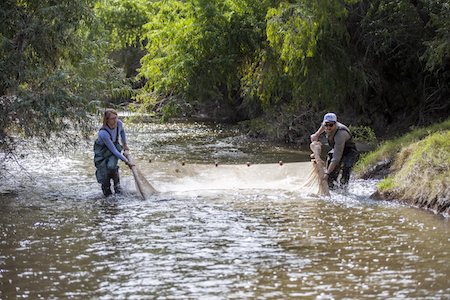When you flush your toilet, you’re helping the recovery of native aquatic species. That may seem strange but let us explain.
We’ve written about one of these species here before: the Gila topminnow. Beginning in about 2017, the Gila topminnow’s miraculous recovery began to make news when it was found in the effluent-dependent Santa Cruz River near the Agua Nueva Wastewater Reclamation Facility.
Recent fish surveys the Pima County Regional Flood Control District’s partners at the Sonoran Institute conducted in the river found topminnow have spread even further downstream from where they were first found. This exciting find suggests the fish might be expanding their range.
Investments in wastewater treatment facility upgrades the Pima County Regional Wastewater Reclamation Department has made, along with the environmental stewardship of County partners at the Sonoran Institute, Arizona Game and Fish Department, and U.S. Fish and Wildlife Service, have contributed to the topminnow’s resurgence.

These investments expanded capacity for future generations and implemented sophisticated treatment processes that remove more impurities from wastewater resulting in a higher-quality effluent. That effluent, more than 40,000-acre feet of which is discharged each year, is the lifeblood of the Santa Cruz River ecosystem and the reason for the topminnow’s and other species’ resurgence.
The Gila topminnow was once a common species in the entire Gila River Basin, which includes the Santa Cruz River. A variety of threats led to the topminnow’s listing on the Endangered Species list in 1967.
One of the main threats was the introduction of nonnative fish species that through competition or predation wiped out many topminnow populations. Interestingly, though, topminnow in the Santa Cruz River now appear to be persisting despite the presence of nonnative fish species that are known topminnow enemies.
During the most recent fish monitoring survey, led by the Sonoran Institute, participants had the opportunity to get up close and personal with the valiant topminnow and the invading species. In jest, these fish species can be thought of as the Good, the Bad, the Ugly, and the Worst.
The Good: Gila topminnow, a small native fish that gives birth to live babies. Males are smaller than females and can have a black coloration during the breeding season. Lifespan is often a year or less, and reproduction can occur in most months of the year.
The Bad: Green sunfish, a medium-sized fish from the Mississippi River basin, but widely introduced, intentionally and accidentally, throughout the United States. Tolerant of poor water conditions, eggs are laid in nests dug in shallow water and kept oxygenated and free of debris by guard males fanning their fins. With especially large mouths, they eat almost anything that fits in their mouths, including other fish, insects, crayfish, and amphibians.
The Ugly: Black bullhead, a medium-sized catfish from the Mississippi River Basin that has also been widely introduced in many places. Both males and females guard the eggs, and young bullheads form large, packed schools which may be seen swimming in blob formations in shallow water. They are voracious predators of insects, crustaceans, small fish, and amphibians.
The Worst: Western mosquitofish, the evil cousin of the topminnow from the southern part of the Mississippi River Basin, has been introduced in many places across the world. Largely introduced to combat mosquito infestations, more recent work shows that mosquitofish are no more effective than native fish like Gila topminnow and Desert pupfish at reducing mosquito populations. It is nearly identical in appearance to the native topminnow and is directly responsible for eliminating many populations of native topminnow in Arizona.
Though we don’t know how many Gila topminnow occur in this part of the Santa Cruz River, Sonoran Institute’s findings from survey efforts suggest that the native topminnow is doing well upstream of Cortaro Road and holding its own against the Western mosquitofish.
While monitoring efforts lead to questions that remain to be answered, such as identifying the specific factors allowing topminnow to thrive among mosquitofish, it is clear that Gila topminnow are continuing to thrive in the effluent-dependent reach of the Santa Cruz in Santa Cruz County.
The next steps managers and biologists need to take include integrating best practices for aquatic habitat management and restoration along the Santa Cruz River that continue to promote the existence of this native fish.
But for now it’s clear, the high quality of effluent discharged into the river is fueling the resurgence of this native species. And that’s how flushing your toilet helps us preserve our native fish.
This post was created by Pima County and published in the March 12, 2021 External Newsletter. We thank them for permission to share it here. View the original.
